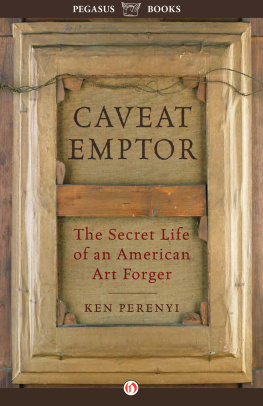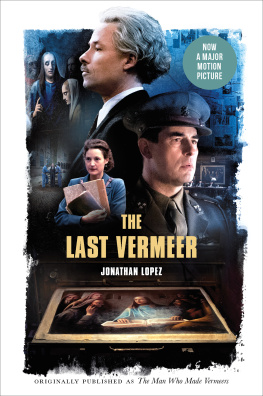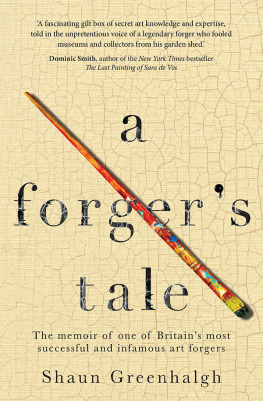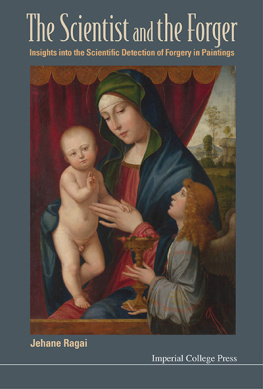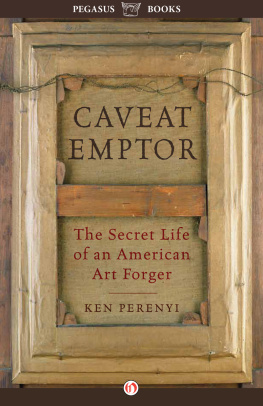CAVEAT EMPTOR
The Secret Life of an American Art forger
KEN PERENYI

PEGASUS BOOKS
NEW YORK LONDON
In memory of
Jos
CHAPTER ONE
The Castle
J ust across the George Washington Bridge from Manhattan lies Bergen County, New Jersey, composed of towns such as Fort Lee, Englewood, Palisades Park, and Edgewater, to name a few. Today Fort Lee, whose splendid location stretches along the Palisades Cliffs, is a mass of high-rises, a spillover from Manhattan, but the Hudson River and the Palisades Cliffs are still as beautiful as I remember them when I was a kid. In the 1950s there wasnt a high-rise to be seen. The towns were more like villages, old-fashioned and unchanged for decades.
I grew up in Palisades Park, a town next door to Fort Lee, in a typical middle-class neighborhood. Dad worked as a machinist and tool-and-die maker at the American Can Company in Jersey City. His fellow workers said he was a genius and could do the impossible. When everybody else was stumped with a mechanical problem and the situation was considered hopeless, thats when they called on Dad.
I attended an ancient schoolhouse that resembled a Gothic fortress. It had wainscoted classrooms, green slate boards, and old wooden desks with inkwells. The initials carved on their surfaces by generations of bad boys dated back to the turn of the century. I hated every single day of school and was chronically in trouble for daydreaming and drawing pictures. I managed to pass from grade to grade by devising ingenious methods of cheating on tests with like-minded classmates.
Life in a town like Palisades Park in the 1950s was like living in the country today. As provincial as it was, though, one could cross the bridge to Manhattan and land on another planet, one of taxicabs, skyscrapers, and millions of people moving at a hundred miles per hour. I grew up aware that New York City was the center of the entire world, a place where you could get anything or be anything you chose to bea place where everybody who was somebody lived.
During the holidays, my Sicilian relatives would visit from Jersey City for an Italian feast. After my grandmother entertained my cousins and me with stories of growing up in Palermo, shed give us pieces of torrone. Each piece of the Italian nougat came packaged in a small, exquisitely decorated box. On the back of each box was a picture of a painting by one of the Italian masters. Each picture was set in a printed gold-leaf frame that highlighted the painting like a miniature masterpiece in a museum. I lined up my empty boxes on my bedroom bureau and was mesmerized by the beauty of these pictures.
No holiday was complete without a hike to Fort Lee, where we spent the day exploring the cliffs. This included a visit to something quite remarkable that would one day change my life and set the stage for my future career. At the very edge of town, perched on a cliff overlooking the river, was an old estate set in its own parklands that cascaded down the side of the cliffs and ended at River Road below. In a clearing near the cliffs edge stood a mysterious-looking house in solitary relief against the sky.
The structure resembled a medieval tower. It stood a full three stories high and had a sinister aspect. As kids, we played on the grounds that descended the side of the cliff. They were filled with strange ruins overgrown with ivy and shrubs. Crumbling walls, lookout towers, and a series of open caves or grottoes were carved into the face of the stone cliff.
Appropriately enough, the locals called the place the Castle. Every imaginable story circulated about it. One held that a Nazi spy had lived there, photographed battleships on the river during World War II, and was caught and shot.
Time passed. I graduated from the ninth grade barely able to recite the alphabet. It was a foregone conclusion Id never make it through high school, so I decided to enter a trade school to learn to be a printer. During this period of my midteens, I finally saw the inside of the mysterious house.
After visiting a friend in Fort Lee one day, I was passing through the grounds of the Castle when I was startled to come face-to-face with an eccentric-looking man. He wore a baggy tweed jacket and an old derby perched atop bushy, graying hair. He cheerfully called out a greeting and engaged me in conversation.
Do you live in the Castle? I asked him.
No, I live in the city, he said, but I stay here when Im working for the artist who does. He then introduced himself as Don Rubow, artists assistant and technician, and surprised me with an irresistible invitation to see inside the house. Don led the way to the entrance at the side and up a stairwell to the second floor. We then entered a large, airy room with high ceilings and walls framed in antique paneling. Well-worn pieces of vintage furniture graced the room. My eye was drawn to an alcove with a big picture window that offered a spectacular view of the Hudson River and Manhattan.
The trappings of an artists studio caught my attention. Paints, palettes, and coffee cans filled with brushes were arranged on worktables that stood next to a drafting table splattered with paint. Half-finished sketches and drawings were tacked haphazardly on the walls. A pair of French doors that opened onto a balcony served as a source of light. Across the room, an entire wall was taken up by a magnificently carved antique breakfront that housed a sound system. Another wall was covered with built-in bookshelves filled with volumes. I was enthralled with my surroundings but wondered what anyone could want with so many books.
My host disappeared into the kitchen and returned with two glasses of soda. Don Rubow was forty-two, a soft-spoken beatnik-artist-philosopher who lived in Greenwich Village. He explained that the house was inhabited by people from the city who had come here to establish a design studio. He mentioned that they were in the city on business, and he rambled on about art and the equipment used in their work, but I wasnt paying much attention. Instead, I was looking around and thinking how cool it must be to live in this place.
When it came time to leave, I thanked Don, and he invited me to drop by again. I didnt need any coaxing. A week later, I approached the Castle through a path in the woods, intending to visit, but just then a car pulled up and parked near the house. I was stunned when the car door opened and a well-tanned, exceptionally handsome man got out stark naked. He proceeded to pull a large towel from the car, drape it around his body, and stride toward the house like Caesar. I remained unobserved and thought it best to come by another time.
I was very bored with my life. The school I went to, Bergen Tech, aka Bourbon Tech, turned out to be nothing more than a repository for every flunky and JD in the county. The place was a madhouse with kids straight out of reformatories and was the perfect incubator for the criminal mind. The standard curriculum for incoming students was:
A) Gambling
B) Smoking
C) Drinking
The good part about the school was that hardly anyone failedand those who did were held in the highest esteem by the entire student body. The bad part was that you might as well have wiped your ass with the diploma they gave you. Few businesses were foolhardy enough to hire graduates from that school. After two years of technical education, I still had no inkling of how a printing press operated, except to press the button that said on. There was some semblance of a classroom schedule, but before long kids started throwing things at each other and the place exploded into mass hysteria. Desks went flying right out of windows, and teachers had nervous breakdowns.

